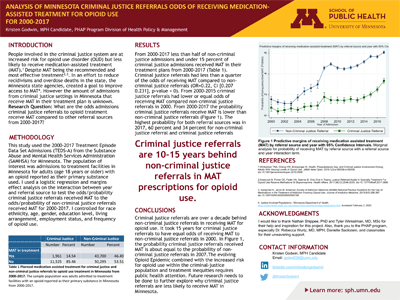Kristen Godwin
MPH, Public Health Administration & Policy
Recipient of the Student Public Health Opioid Research prize, awarded by the SPH Alumni Society.
Advisor:
Dr. Nathan Shippee
Educational Objectives:
Compare the odds of receiving medication-assisted treatment (MAT) for opioid use with a criminal justice referral compared to all other sources of referrals in the state of Minnesota from 2000-2017.
Keywords:
Criminal justice, Opioid
Abstract
Background: People who are involved in the criminal justice system are more likely to report opioid use, however few jails, prisons, or community supervision programs follow recommended treatment. Nationally, only 5 percent of admissions to opioid use treatment with criminal justice referrals receive MAT. MAT is clinically recommended and more effective than others forms of treatment for opioid use disorder (OUD). The odds of criminal justice admission referrals receiving MAT in Minnesota is unknown.
Methods: I used Minnesota SAMHSA TEDS-Admissions data for 2000-2017 and a logistic regression with a marginal analysis and interaction term for referral source and year to compare the odds of criminal justice referrals receiving MAT to non-criminal justice referrals. The sample population was adult admissions with an opioid reported as their primary substance.
Results: From 2000-2017 Criminal justice referrals had less than a quarter of the odds of receiving MAT compared to non-criminal justice referrals (OR=0.22, CI [0.207 0.231], p-value < 0). The probability criminal justice referrals receive MAT is consistently lower than non-criminal justice referrals. Maximum probability for non-criminal justice referrals was 60 percent and 34 percent for criminal justice referrals.
Conclusions: Criminal justice referrals are a decade behind non-criminal justice referrals in receiving MAT in their treatment plan. Further research to explain and correct this inequity is needed.

View Poster (PDF)
